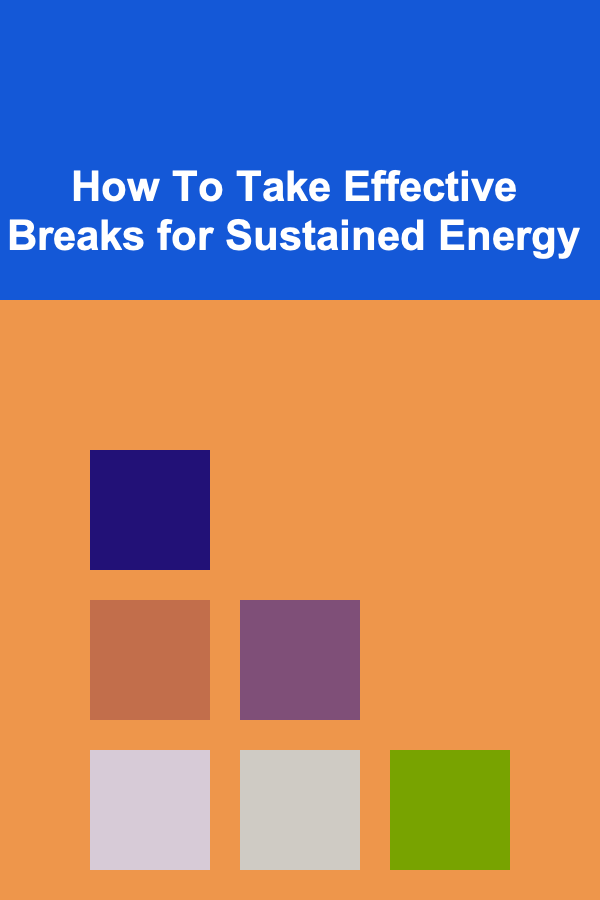
How To Take Effective Breaks for Sustained Energy
ebook include PDF & Audio bundle (Micro Guide)
$12.99$8.99
Limited Time Offer! Order within the next:

In our modern, fast-paced world, staying productive and energized throughout the day can often seem like a challenge. Whether you're working in an office, studying, or managing your own business, the constant pressure to maintain focus and efficiency can lead to burnout if you don't take the right steps to recharge. One of the most effective yet often overlooked strategies for sustaining energy is taking breaks. However, not all breaks are created equal. Understanding how to take effective breaks can make a significant difference in how energized and productive you feel throughout the day.
This article explores the science behind breaks, why they are essential for sustained energy, and how to take breaks that will truly recharge your mind and body.
The Science Behind Breaks
Before diving into how to take effective breaks, it's important to understand why they are so crucial. The human brain is not designed to work for long, uninterrupted periods. Studies have shown that our brains have a limited capacity for sustained focus. The concept of "cognitive load" refers to the mental effort required to perform a task. The more complex or challenging the task, the greater the cognitive load. Once this load exceeds a certain threshold, our focus begins to diminish, and our energy levels drop.
Research has shown that taking breaks helps to alleviate mental fatigue, restore energy, and improve performance. A study conducted by the University of Illinois found that people who took short, regular breaks performed better on tasks and were less fatigued than those who worked continuously without rest. Breaks can help reset your cognitive resources, prevent burnout, and increase your overall efficiency.
Additionally, breaks are beneficial for physical well-being. Sitting or standing in one position for too long can lead to discomfort and strain. Taking regular breaks helps to improve circulation, reduce muscle stiffness, and decrease the risk of long-term health issues such as back pain and eye strain.
The Types of Breaks
Not all breaks are equally effective. The key to a restorative break is understanding the different types of breaks you can take and how to use them appropriately. Below are some common types of breaks, each serving a different purpose:
1. Short Breaks (Microbreaks)
A microbreak is a brief pause from your work that typically lasts between 1 to 5 minutes. These breaks are designed to offer a quick mental reset without significantly disrupting your workflow. A microbreak can be something as simple as standing up, stretching, or taking a few deep breaths.
Microbreaks help to combat eye strain, improve posture, and alleviate mental fatigue. They are ideal for moments when you're feeling a slight drop in energy or focus but don't need a long break. Integrating microbreaks into your day can increase productivity and help maintain steady energy levels.
2. Medium Breaks (Refueling Breaks)
Medium breaks typically last between 15 to 30 minutes and are ideal for recharging your energy more thoroughly. During a medium break, you should step away from your work entirely to do something refreshing. This is an excellent time for activities like going for a short walk, grabbing a snack, or chatting with a colleague.
The key to a successful medium break is engaging in an activity that is different from your primary work, allowing your brain to fully disengage from the task at hand. These breaks help you return to your work with renewed energy, focus, and motivation.
3. Long Breaks (Power Breaks)
Long breaks are typically scheduled during lunch hours or at mid-afternoon. These breaks usually last anywhere from 45 minutes to 1 hour. A power break is a longer period of time when you can completely step away from your workspace and engage in activities that nourish both the body and mind.
A healthy lunch, a longer walk, or even a power nap can help you feel recharged and ready to tackle the rest of your day. Power breaks allow you to give your brain and body the time they need to recover from the intensity of work, which is essential for maintaining consistent energy levels throughout the day.
The Benefits of Taking Breaks
The positive impact of taking effective breaks extends beyond simply feeling refreshed. Numerous benefits arise from incorporating breaks into your daily routine.
1. Improved Focus and Productivity
Taking breaks helps you to maintain focus and avoid burnout. When you work for long periods without resting, your brain's ability to focus diminishes, and the quality of your work may suffer. By taking breaks, you give your brain a chance to recover and refocus, leading to improved concentration and overall productivity.
2. Enhanced Creativity and Problem-Solving Skills
Breaks are known to stimulate creativity. When you step away from your work, your mind continues to process information in the background. This can lead to "aha" moments or creative insights that you may not have had while working in a focused state. Breaks encourage lateral thinking and problem-solving skills, making them an essential part of creative tasks.
3. Reduction in Stress and Mental Fatigue
Constant work without breaks can lead to heightened stress and mental fatigue. Taking regular breaks provides a mental reset, reducing stress and promoting a sense of well-being. The act of stepping away from work and engaging in an activity you enjoy helps lower cortisol levels, the hormone associated with stress.
4. Improved Physical Health
Sitting for extended periods or staying in one position can negatively affect your physical health. Regular breaks help improve circulation, reduce the risk of musculoskeletal problems, and alleviate eye strain. For those who spend long hours working on computers, taking breaks to look away from the screen and stretch can significantly reduce the risk of developing conditions like carpal tunnel syndrome or digital eye strain.
5. Better Emotional Well-being
Taking breaks can also positively impact your emotional well-being. Stepping away from work gives you time to relax, recharge, and refocus on what really matters. A mental break allows you to regain emotional equilibrium, reducing feelings of frustration and burnout.
How to Take Effective Breaks
Now that we understand why breaks are important and the different types of breaks available, it's time to explore how to take breaks effectively. Below are some strategies for optimizing your breaks and ensuring they serve their purpose.
1. Plan Your Breaks in Advance
Effective break-taking isn't about randomly deciding to take a break whenever you feel tired. Planning your breaks in advance is essential to ensure they are meaningful and productive. Schedule short microbreaks every hour or so, depending on the type of work you're doing, and plan for longer breaks during lunch or mid-afternoon.
Use a timer or a productivity tool like the Pomodoro Technique to help remind you when it's time for a break. This structure allows you to work efficiently while also ensuring that you don't skip necessary pauses throughout the day.
2. Engage in Physical Activity
Physical activity is one of the best ways to refresh your mind and body during a break. Even if you only have a few minutes, moving your body can stimulate blood flow, reduce muscle tension, and help you feel more energized. Consider stretching, going for a quick walk, or doing some light exercises. If possible, step outside to get some fresh air and sunshine, which can boost your mood and energy levels.
3. Practice Mindfulness or Meditation
Mindfulness practices like meditation can be incredibly beneficial during a break. Meditation helps calm the mind, reduce stress, and improve focus. Even a short 5-minute session of deep breathing or mindfulness can help reset your brain, making it easier to return to work with renewed focus and clarity.
4. Disconnect from Technology
One of the most effective ways to take a true mental break is by disconnecting from technology. Taking a break from screens (phones, computers, tablets, etc.) gives your brain the opportunity to relax without the constant barrage of notifications and digital distractions. Engage in activities like reading a book, listening to music, or having a face-to-face conversation with a colleague. This type of disconnection allows you to fully recharge and return to work with greater clarity.
5. Stay Hydrated and Nourished
Hydration and nutrition are crucial factors in maintaining energy levels. During breaks, make sure to hydrate and fuel your body with healthy snacks or meals. Opt for nutritious options like fruits, nuts, or a light salad to sustain energy throughout the day. Avoid sugary snacks or caffeine, as they can lead to energy crashes later on.
6. Engage in Creative or Relaxing Activities
Engaging in creative or relaxing activities during a break can help you disconnect from work and boost your overall well-being. You can draw, write, play an instrument, or engage in a hobby you enjoy. These activities allow you to express yourself, recharge, and return to work feeling more focused and rejuvenated.
Conclusion
Incorporating effective breaks into your daily routine is one of the simplest and most powerful strategies for maintaining sustained energy throughout the day. By understanding the science behind breaks, recognizing their benefits, and using strategies that promote mental and physical recovery, you can enhance your productivity, creativity, and well-being.
Remember, breaks are not a luxury---they are a necessity for maintaining long-term focus, performance, and overall health. So, take the time to plan and implement regular breaks into your day, and watch your energy and productivity soar.

How to Clean Your Refrigerator and Freezer Effectively
Read More
How to Safely Clean and Maintain Your Appliances
Read More
How to Style Your Dining Table for Everyday Use
Read More
Why Organizing Your Bookshelf by Color is Visually Appealing
Read More
How to Understand DAOs (Decentralized Autonomous Organizations) on Blockchain
Read More
How To Protect Your Financial Accounts Online
Read MoreOther Products

How to Clean Your Refrigerator and Freezer Effectively
Read More
How to Safely Clean and Maintain Your Appliances
Read More
How to Style Your Dining Table for Everyday Use
Read More
Why Organizing Your Bookshelf by Color is Visually Appealing
Read More
How to Understand DAOs (Decentralized Autonomous Organizations) on Blockchain
Read More